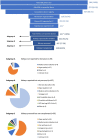Kidney utilization in the Netherlands - do we optimally use our donor organs?
- PMID: 36318454
- PMCID: PMC9976738
- DOI: 10.1093/ndt/gfac300
Kidney utilization in the Netherlands - do we optimally use our donor organs?
Abstract
Background: To ensure optimal utilization of deceased donor kidneys, it is important to understand the precise reasons why kidneys are discarded. In this study we aimed to obtain a comprehensive overview of kidney utilization and discard during the entire donation process in the Netherlands.
Methods: In this retrospective cohort study we analysed kidney utilization of 3856 kidneys in the Netherlands between 1 January 2015 and 31 December 2020. For every kidney that was not transplanted, we determined the moment of and reason for discard through a unique case-by-case assessment.
Results: Kidney discard according to the traditional definition (procured but not transplanted) was 7.8%. However, when kidneys that seemed medically suitable at the beginning of the donation process were also included, many more potential donor kidneys were lost and the total non-utilization was 24.4%. Subjectively presumed impaired organ quality was responsible for 34.2% of all discarded kidneys. Two-thirds of kidneys discarded due to acute kidney injury (AKI) had only AKI stage 1 or 2.
Conclusion: The classical definition of organ discard underestimates the non-utilization of deceased donor kidneys. Strategies to improve kidney utilization could be a revision of the maximum allowed agonal time in donation after circulatory death, careful consideration in reporting and accepting kidneys from donors with AKI and a prospectively filled registry of detailed organ discard reasons, including the 'silent' non-utilization before procurement.
Keywords: discard; kidney utilization; organ donation.
© The Author(s) 2022. Published by Oxford University Press on behalf of the ERA.
Figures


References
-
- Eurotransplant Foundation . The Eurotransplant Manual. Chapter 4. Kidney (ETKAS and ESP). https://www.eurotransplant.org/wp-content/uploads/2022/08/H4-Kidney-2022... (12 November 2022, date last accessed).
-
- Eurotransplant Foundation . Eurotransplant Annual Reports. https://www.eurotransplant.org/statistics/annual-report (1 May 2020, date last accessed).
-
- National Health Service . The National Organ Retrieval Service and Usage of Organs 2018–2019. https://www.organdonation.nhs.uk/helping-you-to-decide/about-organ-donat... (11 May 2020, date last accessed).
Publication types
MeSH terms
LinkOut - more resources
Full Text Sources
Medical

